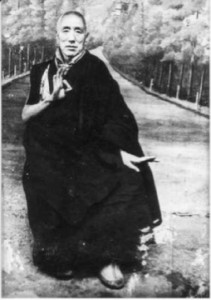From the time of the historical Buddha to the present day, an unbroken succession of great beings have achieved enlightenment and have dedicated themselves to teaching others the path that leads to awakening. Buddhism was brought from India to Tibet over several generations, starting with King Songtsen Gampo in the 6th century AD, and was finally established as the state religion under King Trisong Detsen in the 8th century AD. In Tibetan Buddhism there is a widespread tradition of recognizing the reincarnations of highly realized teachers. Such incarnations are known as tulkus. They take rebirth out of compassion, and to carry on the responsibilities of their previous incarnations. The Khyentses are such a lineage of reincarnate tulkus.
JAMYANG KHYENTSE WANGPO (1820-1892)
 |
“Great chariot of the entire Buddhist teaching, Spiritual friend caring for students without distinction, Free from doctrinal bias, crown jewel of all teachings, I supplicate you!”
– Jamgön Kongtrul LodrötayeJamyang Khyentse the Great, born in 1820, was regarded as an exceptional master – a scholar, mystic, author, and meditator par excellence. In his youth he travelled all over Tibet, receiving innumerable spiritual teachings, including lineages that were almost extinct. He is known to have studied with over 150 of the greatest Buddhist masters of his day. In his late thirties he retired to a small room in the Sakya monastery of Dzongsar, near Derge in eastern Tibet, where for the remainder of his life he practised and mastered the teachings he had received. In many cases he revived the lineage, writing commentaries and passing on the instructions to individuals capable of holding them. |
He was regarded as the last of the Five Tertön Kings who were prophesised by Guru Padmasambhava in the 9th century, and he held the Seven Transmissions of treasure teachings. His collected works consist of 35 volumes, covering all aspects of mysticism and scholarship, and he also worked closely with his student and colleague, Jamgön Kongtrul Lodrötaye, on that master’s famous Five Treasuries.
He was an authority on all the different teachings of Buddhism in Tibet, as well as the pre-Buddhist Bön teachings. Shunning sectarian bias, he encouraged his students to appreciate the profundity of all the existing traditions. This approach became known as Rimey, or the nonsectarian approach. He passed away in 1892, predicting that he would reincarnate in several forms.
DZONGSAR KHYENTSE CHÖKYI LODRÖ (1894-1959)
Our party went together for a formal introduction, exchanging the traditional scarves etc. after which the lama talked to me alone. His room had been left exactly as it was in the time of the great Khyentse and still seemed to exude the power of his spirituality. Khyentse came down from his throne and sat on a cushion in front of me with a welcoming smile. There was a sense of peace, happiness and warmth all around him, but there was also a sense of awe, his words were so profound. (Born in Tibet, 1966)
In the 1950s, Dzongsar Khyentse Rinpoche settled in Sikkim, where he became the guru of the royal family, residing at the palace monastery until he passed away in 1959.
DILGO KHYENTSE RINPOCHE, TASHI PALJOR (1910-1991)
In the years that followed the exodus from Tibet, Dilgo Khyentse Rinpoche became a pillar of the Buddhist educational system and a seemingly inexhaustible source of teachings. In addition to possessing in abundance the qualities of an authentic spiritual master, he was the epitome of selflessness and generosity, travelling wherever he was invited to teach. He would offer teachings endlessly, from early morning to late at night, and would rise at 2-3 every morning to practice until 9. Although he undoubtedly was always immersed in the expanse of unconditional wisdom, to set an example for his students by showing how to practice, and spent in all over 20 years in retreat. He became the chaplain of the Royal Family of Bhutan, as well as a tutor of H.H. the Dalai Lama. Through his teaching and the printing of many rare books, he was responsible for the continuation of many teachings that would have been lost during the cultural changes of the past century. He built stupas and established several retreat centres and monasteries, including the great Shechen Monastery in Nepal. His collected writings are published in 25 volumes. He passed away in 1991.
DZONGSAR KHYENTSE THUBTEN CHÖKYI GYAMTSO
(B. 1961)
His organisation Siddharthas Intent organises Rinpoche’s teachings, while Khyentse Foundation is dedicated to providing for the needs of Rinpoche’s responsibilities.
In this time when the traditional structures of Tibetan Buddhism are facing challenges, and when Buddhism is reaching new audiences, Rinpoche is known for the freedom with which he moves between cultures and people, and his uncompromising dedication to bringing the philosophy and the path of enlightenment to anyone with an open heart. Details on Rinpoche’s activities and teaching programs can be found on siddharthasintent.org.



